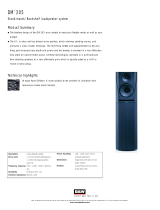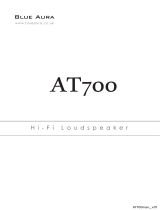
Page 2
1. READ these instructions.
2. KEEP these instructions.
3. HEED all warnings.
4. FOLLOW all instructions.
5. DO NOT use this apparatus near water.
6. CLEAN ONLY with dry cloth.
7. DO NOT block any ventilation openings. Install in
accordance with the manufacturer ’s instructions.
8. DO NOT install near any heat sources such as ra-
diators, heat registers, stoves, or other apparatus
(including ampliers) that produce heat.
9. ONLY USE attachments/accessories specied by
the manufacturer.
10. USE only with a cart, stand, tripod, bracket, or
table specied by the manufacturer, or
sold with the apparatus. When a cart
is used, use caution when moving the
cart/apparatus combination to avoid
injury from tip-over.
11. UNPLUG this apparatus during lightning storms
or when unused for long periods of time.
12. REFER all servicing to qualied service person-
nel. Servicing is required when the apparatus
has been damaged in any way, such as power-
supply cord or plug is damaged, liquid has been
spilled or objects have fallen into the apparatus,
the apparatus has been exposed to rain or
moisture, does not operate normally, or has
been dropped.
Important Safety Instructions
General Cautions
This symbol indicates that there are
important operating and maintenance
instructions in the literature accompany-
ing this unit.
This symbol indicates that dangerous
voltage constituting a risk of electric
shock is present within this unit.
WARNING: To reduce the risk of re or
electrical shock, do not expose this ap-
paratus to rain or moisture.
WARNING: Voltages in this equipment are hazard-
ous to life.
No user-serviceable parts inside. Refer all servicing to
qualied service personnel.
CAUTION: Changes or modications not expressly
approved by the manufacturer could void the user’s
authority to operate.
CAUTION!
RISK OF ELECTRIC SHOCK
DO NOT OPEN
• When making or changing any connections to
your system, switch all the electronics OFF.
• Do NOT listen to music for long periods at
extreme volume settings. Doing so can perma-
nently damage your hearing.
• When running loudspeaker cables, do not trail
them over open oor spaces where they could
cause an accident. Cover them or route them
around potential troublespots.
• Before switching on your sound system, turn
the volume level down. After switching the
system on, turn the level up gradually.
• Do not use extreme settings of Treble, Bass or
EQ. Ideally set the tone controls “at” and turn
any EQ o.
• These loudspeakers are extremely heavy. Do not
move them by yourself. Always get help.
If you are using the oor spikes:
• Spikes are sharp! Exercise extreme caution when
using spikes.
• Do not drag the loudspeaker. Lift the speakers
o the oor and set them down carefully when
changing their location.
• Be especially careful not to place a spiked
loudspeaker in areas where there may be hidden
obstacles that could get damaged.
• Some oor surfaces can be damaged by spikes.
If you are unsure, consult your ooring contrac-
tor for advice before using spikes, or use the
spike seats.






















